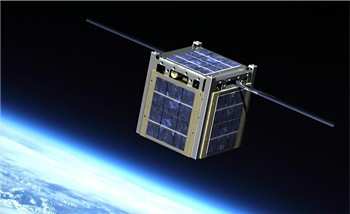Thu, Feb 28, 2013
Twenty-Four Small Satellites Chosen To Fly On Future Missions
NASA has selected 24 small satellites to fly as auxiliary payloads aboard rockets planned to launch in 2014, 2015 and 2016. The proposed CubeSats come from universities across the country, a Florida high school, several non-profit organizations and NASA field centers. CubeSats belong to a class of research spacecraft called nanosatellites. The cube-shaped satellites measure about 4 inches on each side, have a volume of about 1 quart, and weigh less than 3 pounds.

The selections are from the fourth round of the CubeSat Launch Initiative. After launch, the satellites will conduct technology demonstrations, educational research or science missions. The selected CubeSats will be eligible for flight after final negotiations and an opportunity for flight becomes available.
The following organizations submitted winning satellite proposals:
- The Aerospace Corporation, El Segundo, CA.
- The Discovery Museum and Planetarium, Bridgeport, CT.
- Embry-Riddle Aeronautical University, Prescott, AZ.
- Morehead State University, Morehead, KY, in partnership with the University of California at Berkeley
- Montana State University, Bozeman (2 CubeSats) in partnership with The University of New Hampshire, Durham
- Merritt Island High School, Florida, in partnership with California Polytechnic State University, San Luis Obispo
- NASA's Ames Research Center, Moffett Field, CA.
- NASA's Goddard Space Flight Center, Greenbelt, Md. (3 CubeSats)
- NASA's Jet Propulsion Laboratory, Pasadena, CA., in partnership with the California Institute of Technology, Pasadena (3 CubeSats)
- NASA's Kennedy Space Center, Florida
- Pennsylvania State University, in partnership with the Naval Research Laboratory, Monterey, CA., and the Aerospace Corporation, El Segundo, CA.
- Saint Louis University, St. Louis, MO.
- Tyvak Nano-Satellites Systems, Irvine, CA., in partnership with the California Polytechnic State University, San Luis Obispo
- University at Buffalo, The State University of New York
- University of Colorado, Boulder
- University of Florida, Gainesville, in partnership with Stanford University
- University of Maryland, Baltimore County
- University of Texas, Austin
- Vanderbilt University, Nashville, TN, in partnership with the Radio Amateur Satellite Corporation, Silver Spring, MD.
In the three previous rounds of the CubeSat initiative, NASA has selected 63 missions for flight. The agency's Launch Services Program Educational Launch of Nanosatellite (ELaNa) Program has launched 12 CubeSat missions. This year, 22 CubeSat missions are scheduled for flight.
(CubeSat image provided by NASA)
More News
Aero Linx: Model Aeronautical Association of Australia MAAA clubs are about fun flying, camaraderie and community. For over 75 years, the MAAA has been Australia’s largest fl>[...]
Touchdown Zone Lighting Two rows of transverse light bars located symmetrically about the runway centerline normally at 100 foot intervals. The basic system extends 3,000 feet alon>[...]
“Discovery and innovation are central to our mission at Virgin Galactic. We’re excited to build on our successful record of facilitating scientific experiments in subor>[...]
How To Get A Story On Aero-TV News/Feature Programming How do I submit a story idea or lead to Aero-TV? If you would like to submit a story idea or lead, please contact Jim Campbel>[...]
Student Pilot Reported That During Rotation, “All Of A Sudden The Back Of The Plane Kicked To The Right..." Analysis: The student pilot reported that during rotation, “>[...]
 ANN's Daily Aero-Linx (05.02.24)
ANN's Daily Aero-Linx (05.02.24) ANN's Daily Aero-Term (05.02.24): Touchdown Zone Lighting
ANN's Daily Aero-Term (05.02.24): Touchdown Zone Lighting Aero-News: Quote of the Day (05.02.24)
Aero-News: Quote of the Day (05.02.24) ANN FAQ: Contributing To Aero-TV
ANN FAQ: Contributing To Aero-TV NTSB Final Report: Cirrus Design Corp SR20
NTSB Final Report: Cirrus Design Corp SR20



